|
|
|
Radschool Association Magazine - Vol 44 Page 12 |
|
Privacy Policy | Editorial Policy | Profit Policy | Join the Association | List of Members | Contact us | Index | Links |
|
Back Go to page: 1 2 3 4 5 6 7 8 9 10 11 12 13 14 15 16 17 18 19 20 Forward |
|
|
|
But will it Fly?
There has been a lot written about the Joint Strike Fighter. Some say it is the most advanced machine ever designed and built while others insist it is a super expensive dud. Adam Ciralsky, an award-winning journalist, TV producer and attorney, from CBS News' 60 Minutes is not a fan. This is what he says:
“The Joint Strike Fighter is the most expensive weapons system ever developed. It is plagued by design flaws and cost overruns. It flies only in good weather. The computers that run it lack the software they need for combat. No one can say for certain when the plane will work as advertised. Until recently, the prime contractor, Lockheed Martin, was operating with a free hand—paid handsomely for its own mistakes. Looking back, even the General now in charge of the program can’t believe how we got to this point.
At nearly 500,000 acres,
Eglin Air Force Base
is not the most unobtrusive piece of real
With F-15s and F-16s circling overhead, I drove to the main gate at Eglin, where I was escorted through security and over to the air force’s 33rd Fighter Wing, which is home to the F-35 Lightning II, also known as the Joint Strike Fighter, and some of the men who fly it. The Joint Strike Fighter, or J.S.F., is the most expensive weapons system in American history. The idea behind it is to replace four distinct models of aging “fourth generation” military jets with a standardized fleet of state-of-the-art “fifth generation” aircraft. Over the course of its lifetime, the program will cost approximately $1.5 trillion. Walking around the supersonic stealth jet for the first time, I was struck by its physical beauty. Whatever its shortcomings—and they, like the dollars invested in the plane, are almost beyond counting—up close it is a dark and compelling work of art. To paraphrase an old Jimmy Breslin line, the F-35 is such a bastardized thing that you don’t know whether to genuflect or spit.
When the J.S.F. program formally got under way, in October 2001, the
Department of Defense unveiled plans to buy 2,852 of the airplanes
in a contract worth an estimated $233 billion. It promised that the
first squadrons of high-tech fighters would be “combat-capable” by
2010. The aircraft is at least seven years behind schedule and
plagued by a risky development strategy, shoddy management,
laissez-faire oversight, countless design flaws, and skyrocketing
costs. The Pentagon will now be spending 70 percent more money for
409 fewer fighters—and that’s just to buy the hardware, not to fly
and maintain it, which is even more expensive. “You can understand
why many people are very, very skeptical about the program,”
Lieutenant General Christopher Bogdan, who has been in
As the man now in charge of the Joint Strike Fighter, Bogdan has held the program and its prime contractor, Lockheed Martin, to scrutiny and found both of them deficient on many counts. The 33rd Fighter Wing’s mission is to host air-force, Marine, and navy units responsible for training the pilots who will fly the F-35 and the “maintainers” who will look after it on the ground. The Marine unit, known as the Warlords, has outpaced the others: the commandant of the Marine Corps, General James Amos, has declared that his service will be the first to field a combat-ready squadron of F-35s. In April 2013, Amos told Congress that the Marines would declare what the military calls an “initial operational capability,” or I.O.C., in the summer of 2015. (Six weeks later, he moved the I.O.C. date to December 2015.) By comparison, the air force has declared an I.O.C. date of December 2016, while the navy has set a date of February 2019.
An I.O.C. declaration for a weapons system is like a graduation ceremony: it means the system has passed a series of tests and is ready for war. The Marines have been very explicit about the significance of such a declaration, telling Congress on May 31, 2013, that “IOC shall be declared when the first operational squadron is equipped with 10-16 aircraft, and US Marines are trained, manned, and equipped to conduct [Close Air Support], Offensive and Defensive Counter Air, Air Interdiction, Assault Support Escort, and Armed Reconnaissance in concert with Marine Air Ground Task Force resources and capabilities.”
The chief Warlord at Eglin is a 40-year-old lieutenant colonel named David Berke, a combat veteran of both Afghanistan and Iraq. As we walked around the Warlords’ hangar—which for a maintenance facility is oddly pristine, like an automobile showroom—Berke made clear that he and his men are intently focused on their mission: training enough Marine pilots and maintainers to meet the 2015 deadline. Asked whether Washington-imposed urgency—rather than the actual performance of the aircraft—was driving the effort, Berke was adamant: “Marines don’t play politics. Talk to anyone in this squadron from the pilots to the maintainers. Not a single one of them will lie to protect this program.”
During the day and a half I spent with the Warlords and their air-force counterparts, the Gorillas, it became clear that the men who fly the F-35 are among the best fighter jocks America has ever produced. They are smart, thoughtful, and skilled—the proverbial tip of the spear. But I also wondered: Where’s the rest of the spear? Why, almost two decades after the Pentagon initially bid out the program, in 1996, are they flying an aircraft whose handicaps outweigh its proven—as opposed to promised—capabilities? By way of comparison, it took only eight years for the Pentagon to design, build, test, qualify, and deploy a fully functional squadron of previous-generation F-16s (below).
“The F-16 and F-35 are apples and oranges,” Major Matt Johnston, 35,
an air-force instructor at Eglin, told me. “It’s like comparing an
Atari video-game system to the latest and greatest thing that Sony
has come up with. They’re both aircraft, but the capabilities that
the F-35 brings are completely revolutionary.” Johnston, like Berke,
is evangelical about the airplane and insistent that
“programmatics”—the technological and political inner workings of
the J.S.F. effort—are not his concern. He has a job to do, which is
training pilots for the jet fighter that will someday be. He was
candid about, but unfazed by, the F-35’s current limitations: the
squadrons at Eglin are prohibited from flying at night, prohibited
from flying at supersonic speed, prohibited from flying in bad
weather (including within 25
“The helmet is pivotal to the F-35,” Johnston explained. “This thing was built with the helmet in mind. It gives you 360-degree battle-space awareness. It gives you your flight parameters: Where am I in space? Where am I pointing? How fast am I going?” But Johnston and Berke are prohibited from flying with the “distributed aperture system”—a network of interlaced cameras, which allows almost X-ray vision—that is supposed to be one of the airplane’s crowning achievements. The Joint Strike Fighter is still waiting on software from Lockheed that will make good on long-promised capabilities.
When I spoke with Lockheed’s vice president for program integration, Steve O’Bryan, he said that the company is moving at a breakneck pace, adding 200 software engineers and investing $150 million in new facilities. “This program was overly optimistic on design complexity and software complexity, and that resulted in overpromising and under-delivering,” O’Bryan said. He insisted that, despite a rocky start, the company is on schedule. Pentagon officials are not as confident. They cannot say when Lockheed will deliver the 8.6 million lines of code required to fly a fully functional F-35, not to mention the additional 10 million lines for the computers required to maintain the plane.
The chasm between contractor and client was on full display on June 19, 2013, when the Pentagon’s chief weapons tester, Dr. J. Michael Gilmore, testified before Congress. He said that “less than 2 percent” of the placeholder software (called “Block 2B”) that the Marines plan to use has completed testing, though much more is in the process of being tested. (Lockheed insists that its “software-development plan is on track,” that the company has “coded more than 95 percent of the 8.6 million lines of code on the F-35,” and that “more than 86 percent of that software code is currently in flight test.”)
Still, the pace of testing may be the least of it. According to Gilmore, the Block 2B software that the Marines say will make their planes combat capable will, in fact, “provide limited capability to conduct combat.” What is more, said Gilmore, if F-35s loaded with Block 2B software are actually used in combat, “they would likely need significant support from other fourth-generation and fifth-generation combat systems to counter modern, existing threats, unless air superiority is somehow otherwise assured and the threat is cooperative.” Translation: the F-35s that the Marines say they can take into combat in 2015 are not only ill equipped for combat but will likely require airborne protection by the very planes the F-35 is supposed to replace.
The F-35 Joint Strike Fighter was meant to improve the U.S. air arsenal but has made it more vulnerable instead. From all the recent sounds of celebration coming out of Washington, D.C., you might think the Pentagon’s biggest, priciest and most controversial warplane development had accelerated right past all its problems. The price tag, currently an estimated $1 trillion to design, build and operate 2,400 copies, is steadily going down. Production of dozens of the planes a year for the Air Force, Navy and Marine Corps is getting easier. Daily flight tests increasingly are hitting all the right marks.
Or so proponents would have you believe.
“The program appears to have stabilized,” Michael Sullivan from the Government Accountability Office told Congress. “I’m encouraged by what I’ve seen,” chimed in Air Force Lt. Gen. Christopher Bogdan, head of the program on the government side and Lockheed spokesman Laura Siebert she said she expected a “much more positive” article than usual owing to what she described as the program’s “significant progress.”
But the chorus of praise is wrong. The F-35 Joint Strike Fighter , a do-it-all strike jet being designed by Lockheed Martin to evade enemy radars, bomb ground targets and shoot down rival fighters, is as troubled as ever. Any recent tidbits of apparent good news can’t alter a fundamental flaw in the plane’s design with roots going back decades.
Owing to heavy design compromises foisted on the plane mostly by the Marine Corps, the F-35 is an inferior combatant, seriously outclassed by even older Russian and Chinese jets that can fly faster and farther and manoeuvre better. In a fast-moving aerial battle, the JSF “is a dog … overweight and underpowered,” according to Winslow Wheeler, director of the Straus Military Reform Project at the Project on Government Oversight in Washington, D.C. And future enemy planes, designed strictly with air combat in mind, could prove even deadlier to the compromised JSF.
It doesn’t really matter how smoothly Lockheed and the government’s work on the new warplane proceeds. Even the best-manufactured JSF is a second-rate fighter where it actually matters, in the air, in life-or-death combat against a determined foe. And that could mean a death sentence for American pilots required to fly the vulnerable F-35.
The F-35's inferiority became glaringly obvious five years ago in a computer simulation run by John Stillion and Harold Scott Perdue, two analysts at RAND, a think tank in Santa Monica, California. Founded in 1948, RAND maintains close ties to the Air Force. The air arm provides classified data, and in return RAND games out possible war scenarios for government planners. In Stillion and Perdue’s August 2008 war simulation, a massive Chinese air and naval force bore down on Beijing’s longtime rival Taiwan amid rising tensions in the western Pacific. A sudden Chinese missile barrage wiped out the tiny, out-dated Taiwanese air force, leaving American jet fighters based in Japan and Guam to do battle with Beijing’s own planes and, hopefully, forestall a bloody invasion.
In the scenario, 72 Chinese jets patrolled the Taiwan Strait. Just 26 American warplanes, the survivors of a second missile barrage targeting their airfields, were able to intercept them, including 10 twin-engine F-22 stealth fighters that quickly fired off all their missiles. That left 16 of the smaller, single-engine F-35s to do battle with the Chinese. As they began exchanging fire with the enemy jets within the mathematical models of the mock conflict, the results were shocking.
America’s newest stealth warplane and the planned mainstay of the
future Air Force and the air arms of the Navy and Marine Corps, was
no match for Chinese warplanes. Despite their vaunted ability to
evade detection by radar, the JSFs were blown out of the sky. “The
F-35 is double-inferior,” Stillion and Perdue moaned in their
written summary of the war game, later leaked to the press. The
analysts railed against the new plane, which to be fair played only
a small role in the overall simulation. “Inferior acceleration,
inferior climb [rate], inferior sustained turn capability,” they
wrote. “Also has lower top speed. Can’t turn, can’t climb, can’t
run.” Once missiles and guns had been fired and avoiding detection
was no
And partly as a result, the U.S. lost the simulated war. Hundreds of computer-code American air crew perished. Taiwan fell to the 1s and 0s representing Chinese troops in Stillion and Perdue’s virtual world. Nearly a century of American air superiority ended among the wreckage of simulated warplanes, scattered across the Pacific.
In a September 2008 statement Lockheed shot back against the war game’s results, insisting the F-35 was capable of “effectively meeting” the “aggressive operational challenges” presented in the Taiwan scenario. RAND backed away from the report, claiming it was never about jet-to-jet comparisons, and Stillion and Perdue soon left the think tank. Stillion is now at the Centre for Strategic and Budgetary Assessments think tank in Washington, D.C. Perdue currently works for Northrop Grumman. Steve O’Bryan, a Lockheed vice president and former fighter pilot, targeted the war game analysis and its authors. “It was policy people who did that report, [people] with no airplane experience,” O’Bryan said, adding that many critics of the F-35 “are people who are self-proclaimed experts who live in their mom’s basement and wear slippers to work.”
But
Stillion and Perdue are both veteran aviators. Stillion flew in RF-4
recon planes and Perdue in F-15s during the Gulf War. “I don’t live
in my mom’s basement,” Perdue said. Even if its results were
disputable, the 2008 war game should have been a wake-up call.
Among the pathologies inherent in the F-35's design, by far the most damaging is the result of a peculiar institutional obsession by one of the new plane’s three main customers. Early on, the Marine Corps contrived to equip the JSF as a “jump jet,” able to take off and land vertically like a helicopter — a gimmick that the Marines have long insisted would make its fighters more flexible, but which has rarely worked in combat. The JSF comes in three variants, one each for the Air Force, Navy and Marines, all sharing a mostly common fuselage, engine, radar and weapons. The wings and vertical-takeoff gear vary between models.
Altogether the three F-35 variants are meant to replace around a dozen older plane types from half a dozen manufacturers, ranging from the Air Force’s manoeuvrable, supersonic F-16 to the slow-flying, heavily armoured A-10 and, most consequentially, the Marines’ AV-8B Harrier, an early-generation jump jet whose unique flight characteristics do not blend well with those of other plane types.
Engineering compromises forced on the F-35 by this unprecedented need for versatility have taken their toll on the new jet’s performance. Largely because of the wide vertical-takeoff fan the Marines demanded, the JSF is wide, heavy and has high drag, and is neither as quick as an F-16 nor as toughly constructed as an A-10. The jack-of-all-trades JSF has become the master of none.
And
since the F-35 was purposely set up as a monopoly, replacing almost
every other warplane in the Pentagon’s inventory, there are fewer
and fewer true alternatives. In winning the 2001 competition to
build the multipurpose JSF, Lockheed set a course to eventually
becoming America’s sole active builder of new-generation jet
fighters, leaving
If the unthinkable happens and sometime in the next 40 years a real war, as opposed to a simulation, breaks out over Taiwan or some other hot spot, a lot of U.S. jets could get shot down and a lot of American pilots killed. Battles could be lost. Wars could be forfeit.
The oldest of the roughly 50 F-35 prototypes currently in existence is barely seven years old, having flown for the first time in December 2006. But the new plane’s design origins stretch back much farther, to a time before China was a rising world power and even before jet engines. In many ways, America’s new, universal jet was born in the confusion, chaos and bloodshed of World War II’s jungle battlefields.
In
August 1942 a force of U.S. Marines stormed ashore on Guadalcanal,
part of the Solomons Island chain in the South Pacific. Less than a
year after the attack on Pearl Harbor, the U.S. and its allies were
still fighting a defensive action against Japanese forces.
Luckily, the Marine survived his nearly suicidal confrontation with the Zero. But as an organization, the Marine Corps was forever changed by its exposure on Guadalcanal. “The lesson learned was that the U.S. Marine Corps needed to be able to bring its air power with it over the beach because the large-deck Navy aircraft carriers might not always be there,” said Ben Kristy, an official Marine historian.
In the 1950s and ‘60s the Corps bought hundreds of helicopters, a new invention at the time. But what it really wanted was a fighter plane that could launch from the same amphibious assault ships that hauled Marine ground troops. These big assault ships had flat helicopter flight deck areas, but with neither the catapults nor the runway length to support the big, high-performance planes favoured by the Navy. The Marines wanted a “jump jet” capable of taking off from these helicopter decks with a short rolling take-off and returning to land vertically, lighter because of all the fuel it had burned. Besides launching from amphibious ships, the new planes were touted to fly in support of ground troops from so-called “lilypads,” 100 foot concrete patches supposedly quickly installed near the front lines.
The concept became known to engineers as Vertical/Short Takeoff and Landing (V/STOL) or Short Takeoff and Vertical Landing (STOVL). It was subject to extensive, crash-plagued experimentation throughout the early years of the jet age , every STOVL or V/STOL prototype from 1946 to 1966 crashed. “USMC interest in a working V/STOL attack aircraft outstripped the state of aeronautical technology,” Kristy pointed out.
Then in the late ‘60s a British company invented a new jet with complex, rotating engine nozzles that could point downward to provide vertical lift, allowing it to launch from short airstrips or small ships. The Marines fell blindly in love with this temperamental new plane, nicknamed Harrier after a low-flying hawk, and schemed to acquire it for their own air wings. The Navy was the biggest obstacle. The sailing branch controls the Marines’ weapons funding and was not keen to invest in a single-use airplane that only the Corps wanted. At the time the Navy was working with the Air Force on the F-111, an early attempt at a one-size-fits-all jet that the Pentagon believed would replace nearly all older planes with a single, multipurpose model. Thanks to what Kristy described as “very, very shrewd political manoeuvring,” a small group of Marine officers alternately convinced and tricked Congress, the Navy and the U.S. aerospace industry into taking a chance on the Harrier. The Corps ended up buying more than 400 of the compact planes through the 1990s.
But the Harrier, so appealing in theory, has been a disaster in practice. Fundamentally, the problem is one of lift. A plane taking off vertically gets no lift from the wings. All the flight forces must come from the downward engine blast. Forcing the motor to do all the work results in three design drawbacks: a big, hot engine with almost no safety margin; an unsafe airframe that must be thinly built with tiny wings in order to keep the plane’s weight less than the down-thrust of the engine; and minimal fuel and weapons load, also to save weight.
As a result, in vertical mode the Harrier carries far fewer bombs than conventional fighters and also lacks their flying range. And the concentrated downward blast of the Harrier’s vertical engine nozzles melts asphalt and kicks up engine-destroying dirt, making it impossible to operate from roads or even manicured lawns.
In the 1991 Gulf War, the front-line concrete lily pads never showed up, so the jump jet had to fly from distant full-size bases or assault ships. With their very limited fuel, they were lucky to be able to put in five or 10 minutes supporting Marines on the ground and they proved tremendously vulnerable to machine guns and shoulder-fired missiles. Even when it isn’t launching and landing vertically or being shot at, the Harrier is delicate and hard to fly owing to the complex vertical-flight controls and the minimal lift and manoeuvrability of the tiny wings. By the early 2000s a full third of all Harriers had been destroyed in crashes, killing 45 Marines.
“The Harrier was based on a complete lie,” said Pierre Sprey, an experienced fighter engineer whose design credits include the nimble F-16 and the tank-killing A-10. “The Marines simply concocted it because they wanted their own unique airplane and wanted to convert amphibious ships into their own private carriers.” And the Corps stuck with the V/STOL concept for the same pathological reasons. With the crash-prone Harriers dwindling in number and showing their age, in the early ‘80s the Marines started working with the Defence Advanced Research Project Agency’s high-tech dreamers on R&D for a new jump jet. One that had to be supersonic and had to evade radar detection in addition to launching vertically, in essence, tripling down on the Harrier’s false promise by piling on additional requirements that were all “grossly incompatible,” according to Sprey.
After a decade funding Lockheed design and wind tunnel work, mostly through DARPA’s unauditable “black” money, the dreamers concluded that the best way to push a V/STOL jet to supersonic speed was to replace the rotating engine nozzles with a dual system combining a single, rearward-thrusting engine plus a second engine, called a lift fan, installed horizontally in the mid-fuselage.
New but unproven concept in hand, in the early 1990s the Marines emerged into the light to urge Congress to start a mega-procurement program for their supersonic, stealthy jump jet.
In
1993 and 1994, the Navy and Air Force also wanted new jet fighter
designs — ones with the same radar-evading characteristics of the
new F-117 stealth fighter and B-2 stealth bomber. As chance would
have it, all three jet-operating military branches approached
Congress at roughly the same time asking for tens of billions of
dollars to develop and buy new planes. “Congress said we couldn’t
afford that,” said Lt. Gen. Harold Blot, a Harrier
Such jets had a spotty past: some worked; most didn’t. The F-111, the universal fighter from the 1960s, had grown too complicated, heavy and expensive as each branch piled on equipment; only the Air Force ended up buying it — and only a few hundred of the 1,500 copies originally planned. The less complex F-4, however, began as a Navy fighter and was eventually adopted by the Air Force and Marines as well, serving through Vietnam and the Cold War. Congress was hoping to duplicate the F-4's relative success in the 21st century, equipping all the military branches with new, radar-evading jets and saving money in the process.
But the concept for the new universal plane, known early on as the Common Affordable Lightweight Fighter, included a fatal flaw. Where the F-4 had been a conventional plane taking off and landing from runways, CALF (soon renamed Joint Advanced Strike Technology) would be a STOVL plane — because the Marines insisted. “We’re on a 40-year path to get an airplane that’s more responsive,” Blot explained. And to the Corps, that meant a jump jet. Despite the history of failures, Congress bought into the idea of a universal stealth fighter that was also STOVL. But legislators’ embrace of the risky concept did not take place in a vacuum. It was, in part, the outcome of a focused influence campaign by the Lockheed, the company most likely to win the competition to build the new plane.
Lockheed had made its name building specialized interceptors, spy planes and bombers. The F-117, the world’s first operational stealth warplane, was a Lockheed product. An aggressive campaign of corporate acquisitions also brought Sprey’s bestselling F-16 into the Lockheed fold. Those programs positioned Lockheed to make a huge grab for greater market share. Meanwhile, the company’s secret tests for the fringe-science DARPA, meant to prove that a STOVL jet could also fly faster than the speed of sound, provided the basis for the company’s pitch for the universal jet fighter.
Granted, the tests had produced plenty of theories but no working hardware. “The technologies available were not yet advanced enough,” was the government’s official conclusion. But Lockheed spun the experiments as stepping stones to a supersonic jump jet that could also be adapted to suit the Air Force and Navy’s needs. With just one swappable component — the downward-blasting second engine, a single airplane design could do the jobs of the Marines’ vertical-launching Harrier and of the faster, farther-flying conventional planes of the Navy and Air Force.
Convinced by Lockheed and DARPA that the universal STOVL jet concept
could work, in 1996 Congress directed the Pentagon to organize a
contest to build the new plane. General Dynamics, Boeing and
Lockheed drew up blueprints but Lockheed, having worked with DARPA
since the ‘80s, clearly had the advantage. “It wasn’t truly
competitive,” Sprey said of the new fighter contest. “The other
companies were way behind the curve.” General Dynamics, whose main
airplane-making division had been bought by Lockheed, dropped out of
the competition. Boeing cobbled together an ungainly supersonic
prototype called the X-32 whose gaping engine inlet resembled a
grouper in mid-swallow. Rushed, amateurish an
But it flew, barely, starting in September 2000. For the critical vertical-takeoff test the following June, Boeing engineers had to strip off non-critical parts to get the weight down — a glaring flaw the company took pains to keep from the press, but couldn’t hide from government referees. Lockheed’s X-35 was less of a disaster. Sleeker and more efficient than the Boeing plane thanks to Lockheed’s two-decade head start, the faster-than-sound X-35 needed no help taking off vertically for the first time in June 2001. And on the afternoon of Oct. 26, Pete Aldridge, the military’s top weapons buyer, stepped up to a podium in the Pentagon briefing room and announced that Lockheed had won the $19-billion contract to begin developing what was now known as the Joint Strike Fighter.
As Aldridge spoke, 2,600 miles away at a top-secret facility in Palmdale, California, 200 Lockheed engineers whooped and cheered. They had every reason to celebrate. The Pentagon wanted thousands of copies of the JSF to start entering Marine, Navy and Air Force service in 2010, replacing nearly every other jet fighter in the military arsenal , in other words, a monopoly. Once production was factored in, the program was expected to cost at least $200 billion.
Even adjusted for two decades of inflation, that estimate would turn out to be hopelessly, outrageously, low. Among other problems, the fundamental flaws of the STOVL concept inexorably crept into the JSF’s 20-year development, adding delays, complexity and cost.
Where the Harrier has its rotating engine nozzles for downward thrust, the F-35 has a new kind of vertical-lift system combining a hinged main engine nozzle at the back of the plane that points directly backward until the pilot shifts into hover mode, at which point the nozzle swivels 90 degrees to point down.
Simultaneously, a complicated system of shafts, gears and doors activates to reveal the horizontal lift fan installed in the centre of the aircraft just behind the cockpit. Together the fan and nozzle produce more than 40,000 pounds of thrust, enough to lift the nearly 20-ton aircraft straight up off the ground like a gargantuan dragonfly.
The lift fan, devised by Lockheed and DARPA in the early 1980s, was the only workable solution that anyone had come up with to give a plane vertical capability plus supersonic speed and radar-evading stealth, the last of which demands an airplane with a smooth outline and nothing hanging or protruding from it. But this mix of characteristics came at a price to all three F-35 models, even the two that don’t need to take off vertically. “The STOVL requirements have dictated most if not all of the cardinal design elements for all three aircraft,” said Peter Goon, an analyst with the Air Power Australia think tank.
The addition of a lift fan to the baseline F-35 design started a cascade of problems that made it heavier, slower, more complex, more expensive and more vulnerable to enemy attack, problems that were evident in the 2008 war game set over Taiwan. Of course Lockheed exec O’Bryan rejected that assessment, claiming the JSF’s stealth, sensors and aerodynamics make it superior to other planes. “It’s not rocket science,” he insisted.
But in many ways the JSF did become rocket science as it grew more complex. The original X-35 from 2001 had the advantage of being strictly a test plane with no need to carry weapons. But the frontline F-35 needs weapons. And to maintain the smooth shape that’s best for avoiding detection by radar, the weapons need to be carried inside internal bomb bays. Bomb bays would normally go along an airplane’s centreline, but the F-35's centre is reserved for the 50-inch-diameter lift fan. Hence Sprey’s claim that STOVL and stealth are incompatible. |
|
|
|
|
|
To keep down costs all three JSF variants, the Air Force’s basic F-35A, the Marines’ vertical-takeoff F-35B and the Navy F-35C (the RAAF has order the A model) with a bigger wing for at-sea carrier landings, share essentially the same fuselage. And to fit both the F-35B’s lift fan and the bomb bays present in all three models, the “cross-sectional area” of the fuselage has to be “quite a bit bigger than the airplanes we’re replacing,” conceded Lockheed exec Tom Burbage, who retired this year as head of the company’s F-35 efforts.
The extra width violates an important aerospace design principle called the “area rule,” which encourages narrow, cylindrical fuselages for best aerodynamic results. The absence of area rule on the F-35, again, a knock-on effect of the Marines’ demand for a lift fan, increases drag and consequently decreases acceleration, fuel efficiency and flying range. Thus critics’ assertion that supersonic speed can’t be combined with STOVL and stealth, the latter of which are already incompatible with each other.
“We’re dealing with the laws of physics,” Burbage said in his company’s defence when word got out about the JSF’s performance downgrades.
But the hits kept coming, chipping away at the F-35's ability to fight. The addition of the lift fan forces the new plane to have just one rearward engine instead of two carried by many other fighters. (Two engines is safer.) The bulky lift fan, fitted into the fuselage just behind the pilot, blocks the rear view from the cockpit , a shortcoming that one F-35 test pilot said would get the new plane “gunned every time.” That is, shot down in any aerial dogfight by enemy fighters you can’t see behind you. O’Bryan said the JSF’s sensors, including fuselage-mounted video cameras that scan 360 degrees around the plane, more than compensate for the limited rearward view. Critics countered that the video resolution is far worse than the naked eye and completely inadequate for picking up the distant, tiny, minimal contrast dots in the sky that represent deadly fighter threats ready to kill you.
But
there are plenty of other problems with the F-35, some related the
airplane’s layout, some stemming from inexperienced sub-contractors
and still others resulting from poor oversight by a succession of
short-tenure government managers whose major contributions
Lockheed’s F-117 stealth fighter was developed in a breakneck 30 months by a close-knit team of 50 engineers led by an experienced fighter designer named Alan Brown and overseen by seven government employees. Brown said he exercised strict control over the design effort, nixing any proposed feature of the plane that might add cost or delay or detract from its main mission.
The F-35, by contrast, is being designed by some 6,000 engineers led by a rotating contingent of short-tenure managers, with no fewer than 2,000 government workers providing oversight. The sprawling JSF staff, partially a product of the design’s complexity, has also added to that complexity like a bureaucratic feedback loop, as every engineer or manager scrambles to add his or her specialty widget, subsystem or specification to the plane’s already complicated blueprints … and inexperienced leaders allow it.
Many of the JSF’s problems converged in 2004, when Lockheed was forced to admit that the Marines’ F-35B variant was greatly overweight, owing in part to the addition of the lift fan. Ironically, the fan and other vertical-launch gear threatened to make the new plane too heavy to take off vertically. “The short takeoff/vertical landing variant would need to lose as much as 3,000 pounds (1,360 kg) to meet performance requirements,” Lockheed manager Robert Elrod revealed in an annual report. Panicked, Lockheed poured more people, time and money (billed to the government) into a redesign effort that eventually shaved off much of the extra weight , basically by removing safety gear and making fuselage parts thinner and less tough.
O’Bryan said the weight reduction ultimately benefited all three F-35 variants. But the redesigned JSF, while somewhat lighter and more manoeuvrable, is also less durable and less safe to fly. In particular, the elimination of 11 pounds’ worth of valves and fuses made the JSF 25-percent more likely to destroyed when struck by enemy fire, according to Pentagon analysis.
Problems multiplied. Originally meant to cost around $200 billion to develop and buy nearly 2,900 planes expected to make their combat debut as early as 2010, the F-35's price steadily rose and its entry into service repeatedly slipped to the right. Today the cost to develop and manufacture 2,500 of the new planes, a 400-jet reduction , has ballooned to nearly $400 billion, plus another trillion dollars to maintain over five decades of use.
To help pay for the overruns, between 2007 and 2012 the Pentagon decommissioned nearly 500 existing A-10s, F-15s, F-16s and F/A-18s, (15 percent of the jet fighter fleet) before any F-35s were ready to replace them. The first, bare-bones F-35s with half-complete software and only a few compatible weapons aren’t scheduled to make their combat debut until late 2015, the same year that Boeing is slated to stop making the 1990s-vintage F/A-18E/F, the only other in-production jet fighter being acquired by the Pentagon. (F-15s and F-16s are still being manufactured for foreign customers by Boeing and Lockheed, respectively.)
At
the moment the first operational F-35 finally flies its first
real-world sortie two years from
Instead of revitalizing the Pentagon’s air arsenal as intended, the JSF is eating it and putting future war strategy at risk. In 2012 an embarrassed Frank Kendall, the Pentagon’s chief weapons buyer, called the F-35 “acquisitions malpractice.” But Kendall was referring only to the new plane’s delays and cost increases. He didn’t mention the more deadly flaw that had been revealed in Stillion and Perdue’s 2008 air-war simulation: that regardless of when and at what price the F-35 enters service, owing to its vertical-takeoff equipment the new fighter is the aerodynamic equivalent of a lobbed brick, totally outclassed by the latest Russian- and Chinese-made jets.
To add insult to strategic injury, one of the most modern Chinese prototype warplanes might actually be an illicit near-copy of the F-35 — albeit a more intelligent copy that wisely omits the most compromising aspects of the U.S. plane. It’s possible that in some future war, America’s JSFs could be shot down by faster, deadlier, Chinese-made JSF clones.
The September 2012 debut of China’s latest jet fighter prototype, the J-31, seemed to confirm Hagel’s accusation. The new Chinese plane, built by the Shenyang Aircraft Corporation, bears an uncanny external resemblance to the F-35: same twin tail fins, same chiseled nose, same wing shape. “It certainly looks like the Chinese got their hands on some [F-35] airframe data,” said Richard Aboulafia, a vice president at the Teal Group, an arms industry consultancy in Virginia.
But
the J-31 lacks many of the features that were included in the F-35
“mainly or entirely because of STOVL,” according to Aviation Week
writer and fighter expert Bill Sweetman. Namely, the J-31 does not
have a lift fan or even a space for a lift fan. The omission
apparently allowed Chinese engineers to optimize the new plane for
speed, acceleration, manoeuvrability and flying range and to add
good pilot visibility and a second rearward
It could be that China doesn’t know how to build a working lift fan and that’s why they left it off, Aboulafia said. But for a country that has unveiled two different radar-evading stealth warplane prototypes in just the last two years, that seems unlikely. It’s more plausible that China could build a lift fan-equipped plane and has chosen not to.
The
F-35 was compromised by, well, compromise. A warplane can be
manoeuvrable like the F-16, tough like the A-10, stealthy like the
F-117 or a STOVL model like the Harrier. A plane might even combine
some of these qualities, as in the case of Lockheed’s nimble,
radar-evading F-22. But it’s unrealistic to expect a single jet
design to do everything with equal aplomb. Most of all, it’s foolish
to believe a jet can launch and land vertically, a seriously taxing
aerodynamic feat, and also do anything else well. Jet design like
any engineering practice requires disciplined choices. The JSF is
the embodiment of ambivalence, a reflection of the government and
Lockheed’s inability to say that some things could not or should not
be done. “It’s not clear with the F-35 that we had a strong
By contrast, the Chinese J-31 does not appear compromised at all. Surrounded by rivals with powerful air forces, namely India, Russia, Japan and U.S. Pacific Command and with no grudge-holding Marine Corps to hijack fighter design, it would make sense that China prioritized the air-combat prowess of its new jet over any historical score-settling. That apparently apolitical approach to (admittedly illicit) warplane design appears to have paid dividends for the Shenyang-made jet. “With no lift fan bay to worry about, the designers have been able to install long weapon bays on the centerline,” The centerline bay helps keep the J-31 skinny and therefore likely fast and manoeuvrable, in any event, faster and more manoeuvrable than the F-35, which in a decade’s time could be pretty much the only new U.S. jet the Chinese air force might face in battle.
If Stillion and Perdue’s simulation ever comes true and the U.S. goes to war with China in the air, F-35s dragged down by their lift fans could be knocked out of the sky by Chinese-made F-35 clones that are faster and more manoeuvrable, because they never had lift fans. Sprey, the fighter engineer, said he expects the Pentagon to eventually come to terms with the unpleasant truth, that its new universal jet fighter with the foolhardy vertical-takeoff capability could spell the end of an epochal half-century in which America truly dominated the world’s skies. “My prediction is the F-35 will be such an embarrassment it will be cancelled before 500 are built,” he said.
|
|
"The F-35 will be such an embarrassment it will be cancelled before 500 are built." |
|
|
|
Straus Military Reform Project Director Wheeler advocated replacing the F-35 with upgraded A-10s and F-16s pulled from desert storage plus new Navy F-18s fresh off the Boeing production line. These moves would “reverse the continuing decay in our air forces,” Wheeler claimed. Ward said any future warplane should have clear and narrow requirements, as opposed to the F-35's broad, incompatible guidelines. Development timelines should be fast, budgets should be inexpensive, the overall concept should be simple and hardware should be as tiny as possible, Ward recommended. “What you don’t do is hold up complexity as a desirable attribute,” he said.
Sprey warned it could take years of expensive experimentation and a steep learning curve for American aerospace engineers to relearn the principles of sound fighter design that have been lost during the F-35's emerging monopoly and that the only way to get there is to fund a series of inexpensive head-to-head competitions based on head-to-head mock dogfights between rival prototypes. But that investment of time, talent and cost would be better than continuing with an over-budget, past-due warplane that can’t turn, can’t climb and can’t run because it’s hauling around a lift fan that makes Marines feel better about World War II but isn’t actually practical in the present day.
Replacing America’s useless, universal fighter would be a headache, according to Wheeler, but keeping it would be far worse. The F-35, he wrote, “will needlessly spill the blood of far too many of our pilots.”
|
|
|
|
Back Go to page: 1 2 3 4 5 6 7 8 9 10 11 12 13 14 15 16 17 18 19 20 Forward |
|
|
 estate along Florida’s Emerald Coast. It is, however, among the best
guarded. The base is home to top-secret weapons laboratories,
swamp-training facilities for U.S. Special Forces, and the only
supersonic range east of the Mississippi. Even from a great
distance, bands of quivering heat can be seen rising from the miles
of tarmac. At the end of May, I flew into Fort Walton Beach, a
civilian airfield that shares a runway with Eglin, a fact that was
driven home when the regional jet I was on ran over an arresting
wire, a landing aid for fast-moving fighters, while taxiing to the
gate.
estate along Florida’s Emerald Coast. It is, however, among the best
guarded. The base is home to top-secret weapons laboratories,
swamp-training facilities for U.S. Special Forces, and the only
supersonic range east of the Mississippi. Even from a great
distance, bands of quivering heat can be seen rising from the miles
of tarmac. At the end of May, I flew into Fort Walton Beach, a
civilian airfield that shares a runway with Eglin, a fact that was
driven home when the regional jet I was on ran over an arresting
wire, a landing aid for fast-moving fighters, while taxiing to the
gate.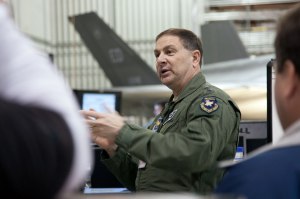 charge of it
since last December, acknowledged when I caught up with him recently
in Norway, one of 10 other nations that have committed to buy the
fighter. “I can’t change where the program’s been. I can only change
where it’s going.”
charge of it
since last December, acknowledged when I caught up with him recently
in Norway, one of 10 other nations that have committed to buy the
fighter. “I can’t change where the program’s been. I can only change
where it’s going.”
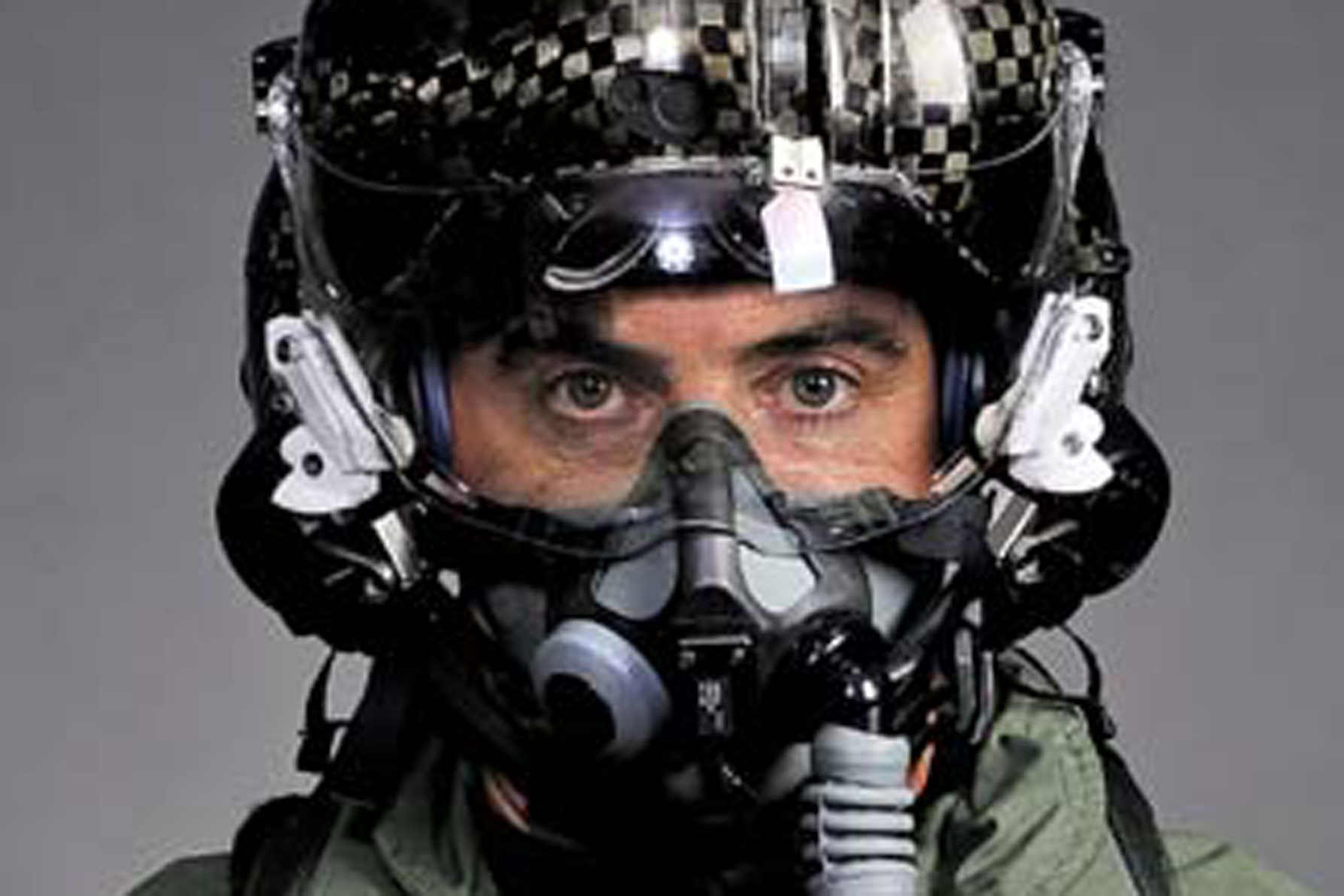 miles of lightning), prohibited from
dropping live ordnance, and prohibited from firing their guns. Then
there is the matter of the helmet.
miles of lightning), prohibited from
dropping live ordnance, and prohibited from firing their guns. Then
there is the matter of the helmet.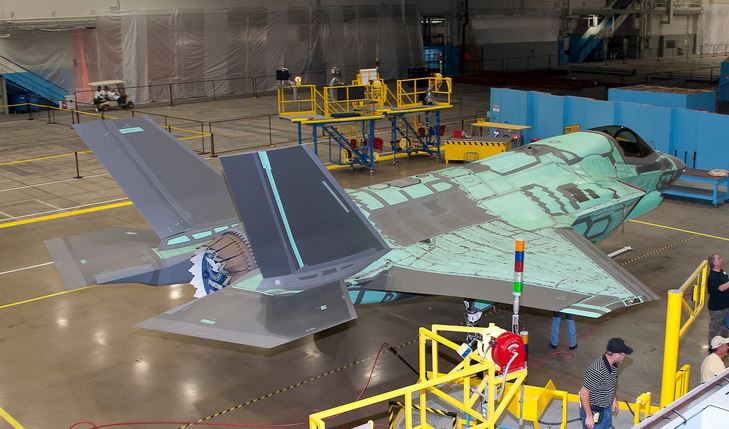
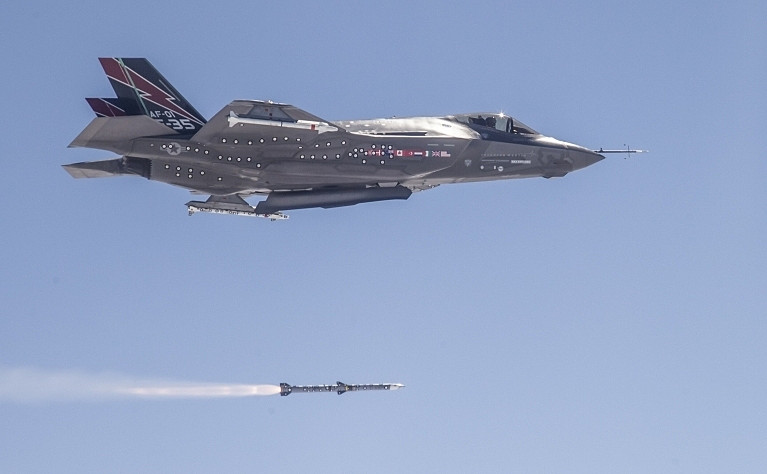
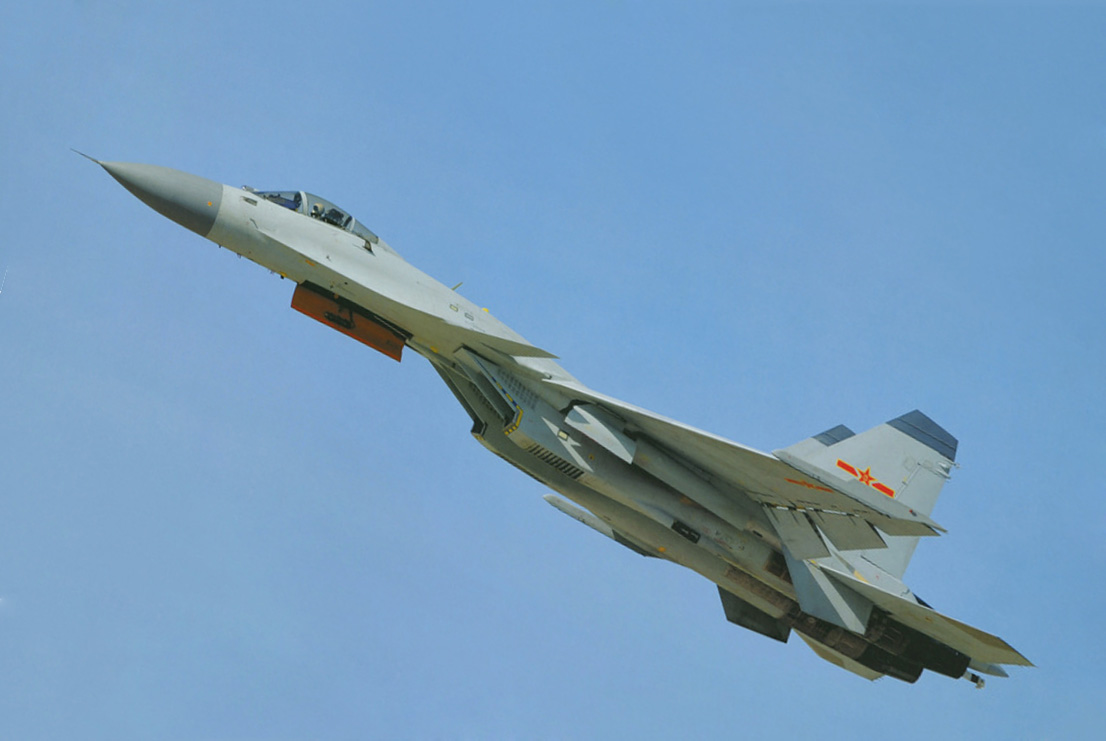 longer an option , in all but the first few seconds of
combat, in other words , the F-35 was unable to keep pace with
rival planes.
longer an option , in all but the first few seconds of
combat, in other words , the F-35 was unable to keep pace with
rival planes. competitors such
competitors such 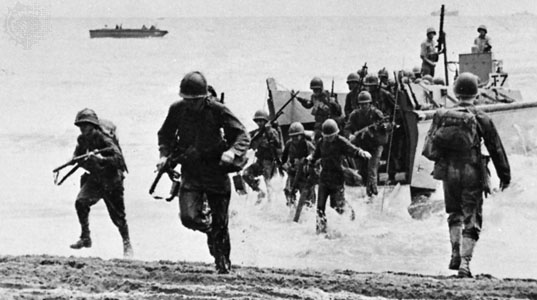 The
Guadalcanal landing was meant to blunt Tokyo’s advance. But the
lightly-equipped Marines ended up surrounded and all but abandoned
after Japanese ships wiped out a portion of the Allied fleet. The
Navy withdrew its precious aircraft carriers, and for months the
Japanese planes, opposed by only a handful of Marine fighters flying
from a crude beachhead airstrip, pounded the hapless Americans.
Robert Leckie, a Marine rifleman on Guadalcanal, described one of
his squad-mates breaking under the strain. The rattled Marine
grabbed a light machine gun , a totally ineffective weapon against
airplanes and charged against a strafing Japanese Zero fighter. “He
could not bear huddling in the pit while the Jap [sic] made sport of
us,” Leckie wrote.
The
Guadalcanal landing was meant to blunt Tokyo’s advance. But the
lightly-equipped Marines ended up surrounded and all but abandoned
after Japanese ships wiped out a portion of the Allied fleet. The
Navy withdrew its precious aircraft carriers, and for months the
Japanese planes, opposed by only a handful of Marine fighters flying
from a crude beachhead airstrip, pounded the hapless Americans.
Robert Leckie, a Marine rifleman on Guadalcanal, described one of
his squad-mates breaking under the strain. The rattled Marine
grabbed a light machine gun , a totally ineffective weapon against
airplanes and charged against a strafing Japanese Zero fighter. “He
could not bear huddling in the pit while the Jap [sic] made sport of
us,” Leckie wrote.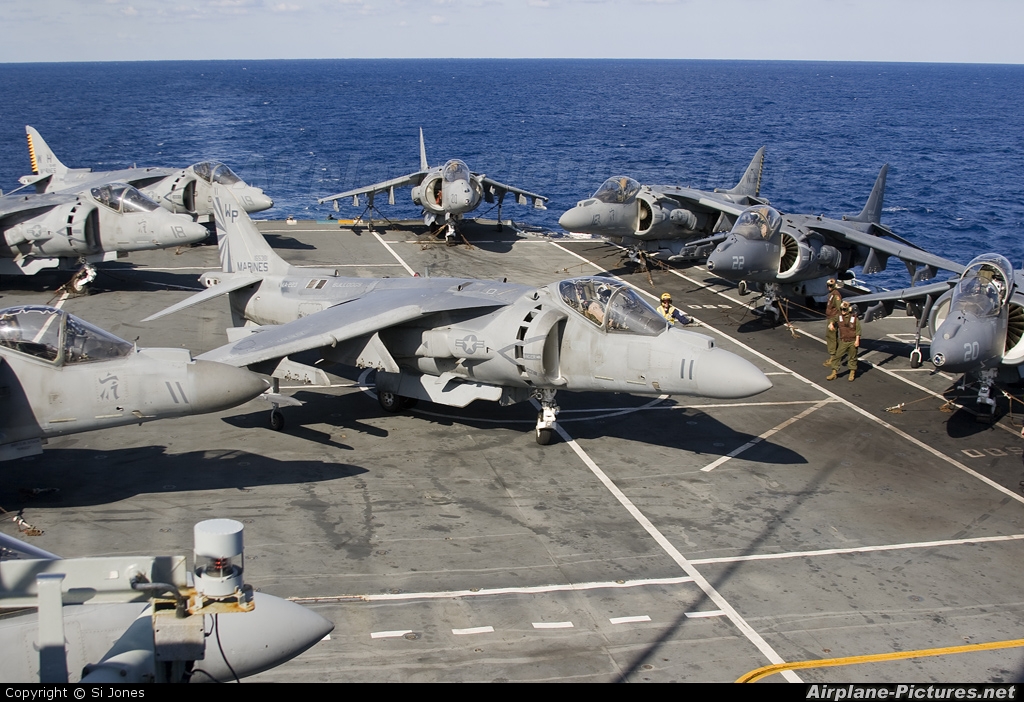
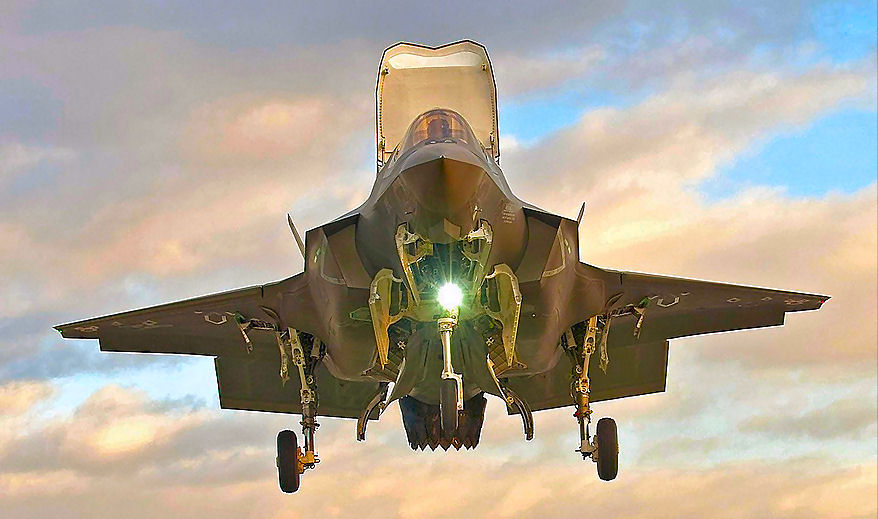

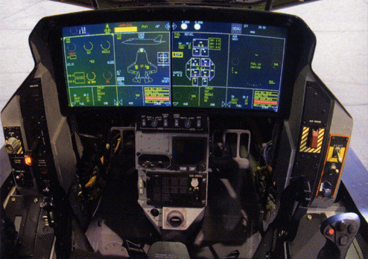 were to grow the bureaucracy involved in the F-35's development.
were to grow the bureaucracy involved in the F-35's development.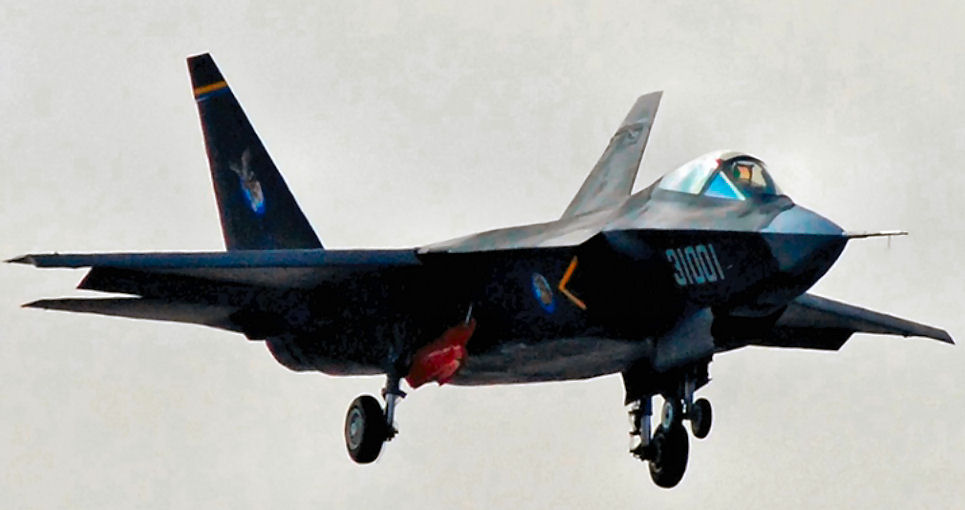 The
Chinese J-31 appears to be based on the F-35. At least twice since
2007 Chinese hackers have stolen data on the F-35 from the
developers’ poorly-guarded computer servers, potentially including
detailed design specifications. Some of the Internet thieves “appear
to be tied to the Chinese government and military,” Defense
Secretary Chuck Hagel claimed.
The
Chinese J-31 appears to be based on the F-35. At least twice since
2007 Chinese hackers have stolen data on the F-35 from the
developers’ poorly-guarded computer servers, potentially including
detailed design specifications. Some of the Internet thieves “appear
to be tied to the Chinese government and military,” Defense
Secretary Chuck Hagel claimed.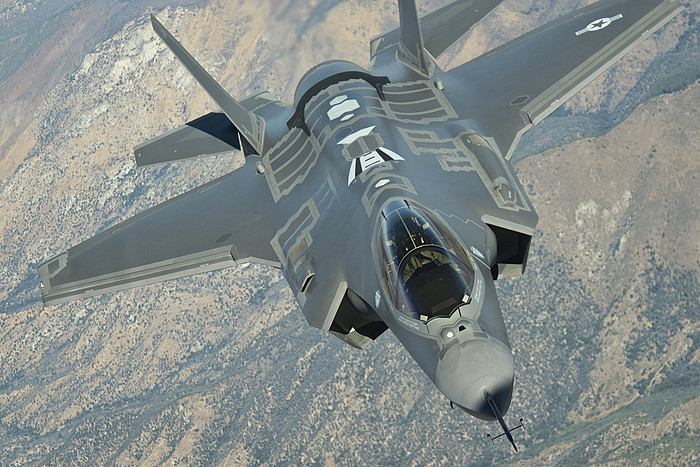 engine instead of having to build the plane around a pretty much
useless vertical-takeoff capability that slows it down, limits it to
one motor and blocks the pilot’s view.
engine instead of having to build the plane around a pretty much
useless vertical-takeoff capability that slows it down, limits it to
one motor and blocks the pilot’s view.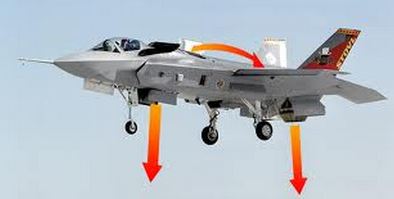 sense of what the top priority was, trying to satisfy the Marines,
the Navy or the Air Force,” said Air Force Lt. Col. Dan Ward, an
expert in weapons acquisition who has been critical of complex,
expensive development efforts.
sense of what the top priority was, trying to satisfy the Marines,
the Navy or the Air Force,” said Air Force Lt. Col. Dan Ward, an
expert in weapons acquisition who has been critical of complex,
expensive development efforts.